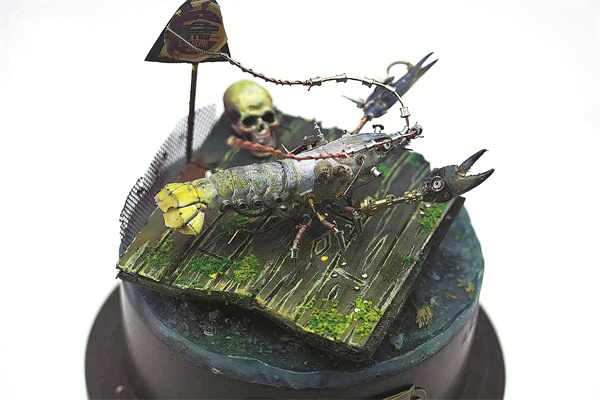

After receiving them, Tan will re-humidify them and carefully peel their carapaces open to remove any soft tissue. He will reposition the legs and wings, and pin the insects to Styrofoam bases, which enables him to add the mechanical embellishments.
"The whole process takes more than a week, which is a test of patience and care," Tan says.
Every day, he spends more than 10 hours at his desk, which is covered with myriad gears and various insect bodies.
Like a doctor performing surgery, Tan cuts a scorpion belly open and spends over an hour removing all the soft tissue and refilling it with sculpting clay. After an anti-corrosion treatment, he begins the creative part — setting a scene and designing the character, which is the "most interesting part" of the process, according to Tan.
Acting like a film director, Tan envisions things, even a complete story, in his mind before setting hands on the insect.
With no background in art, Tan spent about 10,000 yuan for a 10-day 3D modeling course at the Sichuan Fine Arts Institute, which allows him to make his imagination a reality.
Applying the technique, he started to create true-to-life models of different environments, such as deserts and oceans.
"Every creature has its own specialty and, in my design, these features are exaggerated in their particular scene," Tan says.
In a battlefield setting, Tan loaded a giant stag beetle with various "weapons" made of components dismantled from old watches. In his description, the beetle acts like a moving fortress. Another of his creations features a dragonfly with its wings spread.
"Under proper treatment and storage, the steampunk insects can last for a long time," Tan says, adding that he believes they trigger people to reflect on the relationship between people and nature and raise public awareness of biodiversity protection, especially among children.
Although steampunk insect designing is not an art form that can be appreciated by most people, and is not a profession that can make ends meet in China, Tan remains passionate for the craft.
In the future, he plans to create pieces inspired by elements of Chinese mythological literature and films, imbuing his work with a more Eastern aesthetic.